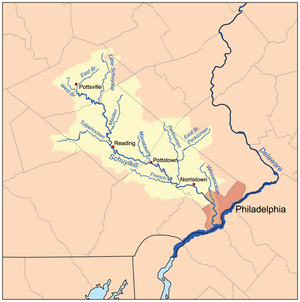Tulpehocken Creek (Pennsylvania) facts for kids
The Tulpehocken Creek is a 39.5-mile (63.6 km) long river in southeastern Pennsylvania, United States. It flows into the Schuylkill River. Long ago, during the time of canals, this creek was a very important waterway. It made up almost half of the Union Canal. This canal connected Philadelphia (a major city) with the Susquehanna River. From there, other canals linked to Lake Erie and new settlements in the western lands.
This creek was a key travel route in early America. It flows through a limestone area in Berks County. This area is south of the Appalachian Mountains. The Tulpehocken Creek is known as one of the best places for trout fishing in southeastern Pennsylvania. In colonial times, the valley around the creek was called "Tulpehocken." It stretched west of Reading. Native American Lenape people lived here. Later, many early German-speaking settlers came to this area. The name "Tulpehocken" comes from a Lenape word, Tulpewikaki. It means "land of turtles." Today, it is a special Pennsylvania Scenic River. Some smaller streams that flow into it are Cacoosing Creek, Spring Creek, and Northkill Creek.
Contents
Where Does Tulpehocken Creek Flow?
The Tulpehocken Creek starts in eastern Lebanon County, Pennsylvania. It generally flows east in a winding path. It goes through Myerstown before entering Berks County. It then passes north of Womelsdorf. At Womelsdorf, it suddenly turns north. After that, it flows southeast. It goes through the Blue Marsh Lake reservoir. Finally, it joins the Schuylkill River at Reading.
Tulpehocken Creek's History and Importance
In the 1720s, the Tulpehocken Creek valley became a popular place for early Swiss and German settlers. Back then, people relied on water power for mills. The creek was perfect for running many milling operations.
Later, in the 1800s, the creek became a vital transportation route. Native American tribes like the Susquehannock and Lenape had used it for their canoes. In 1828, the Union Canal was built along the creek. This canal connected the creek's upper parts to Quittapahilla Creek in Lebanon County.
Pennsylvania was a leader in building canals. As early as 1762, the first lock canal in America was planned here. It would run from near Reading on the Schuylkill River to Middletown on the Susquehanna River.
Canals and Trade Routes
The idea for a canal was studied again in the 1790s. Private companies like the Schuylkill and Susquehanna Navigation Company and later the Union Canal took on the project. The Schuylkill Canal (built in 1822) also ran from Reading to Philadelphia. This allowed large amounts of coal to be shipped to Philadelphia.
Together, the Union Canal and the Schuylkill Canal created one of only two water routes between the Susquehanna River and the Delaware River. The other route was the Chesapeake and Delaware Canal. Using these canals, factories in Philadelphia and New Jersey could send goods west. These goods went to new settlements beyond the Allegheny Mountains and into the Midwest.
The Union Canal and Schuylkill Canal companies were private businesses. They worked with the state-built Pennsylvania Canal. This allowed them to move grain to Philadelphia. The improvements made along Tulpehocken Creek for these two canals made up almost half the length of the final Union Canal, which was finished in 1828.
Blue Marsh Lake and Trout Fishing
Today, the creek is held back by the Blue Marsh Dam above Reading. This dam helps control floods. The U.S. Army Corps of Engineers finished building this earthen dam in 1979. It created the Blue Marsh Lake reservoir.
The dam is designed to release cold water at a steady temperature. This creates a perfect home for rainbow trout and brown trout. These types of fish are added to the stream every year, making it a great spot for fishing.


